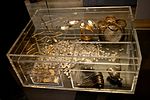Ligula intestinalis is a tapeworm of fish, fish-eating birds and copepods, with species from each group featuring in its complex life cycle. Ligula intestinalis...
3 KB (262 words) - 22:08, 30 April 2024
Clavariadelphus ligula, commonly known as the strap coral, is a species of fungus in the family Gomphaceae. It produces club-shaped fruit bodies with spongy...
9 KB (822 words) - 21:37, 5 July 2024
Taenia of fourth ventricle (redirect from Ligula)
In the brain, the taenia of the fourth ventricle (lingula, tenia of fourth ventricle) are two narrow bands of white matter, one on either side, which complete...
3 KB (197 words) - 08:02, 9 November 2024
Graphicomassa ligula is a species of sea snail, a marine gastropod mollusc in the family Columbellidae, the dove snails. The shell size varies between...
2 KB (149 words) - 02:03, 16 June 2024
Josia ligula is a moth of the family Notodontidae. It is found in South America, on the lowlands of the Amazon basin, the Guiana shield, and the Atlantic...
953 bytes (42 words) - 16:19, 5 January 2021
Elachista ligula is a moth of the family Elachistidae. It is found in Australia. Wikimedia Commons has media related to Elachista ligula. Wikispecies has...
784 bytes (53 words) - 00:15, 1 December 2023
Ursicinus" Three spoons (ligula or cignus) 1994,0408.84–85 AVRVRSICINVS Aur[elius] Ursicinus "Aurelius Ursicinus" Two spoons (ligula or cignus) 1994,0408...
78 KB (8,504 words) - 19:45, 16 August 2024
section, and furthest anterior. The prementum bears a structure called the ligula; this consists of an inner pair of lobes called glossae and a lateral pair...
16 KB (1,834 words) - 01:23, 11 August 2024
of the labium. The mentum bears the palps, glossae, paraglossae, and/or ligula. On the human face, the mentum refers to the protruding part of the chin...
1 KB (96 words) - 12:19, 2 July 2023
Conistra ligula, the dark chestnut, is a moth of the family Noctuidae. The species was first described by Eugenius Johann Christoph Esper in 1791 and it...
4 KB (363 words) - 10:48, 12 January 2023








